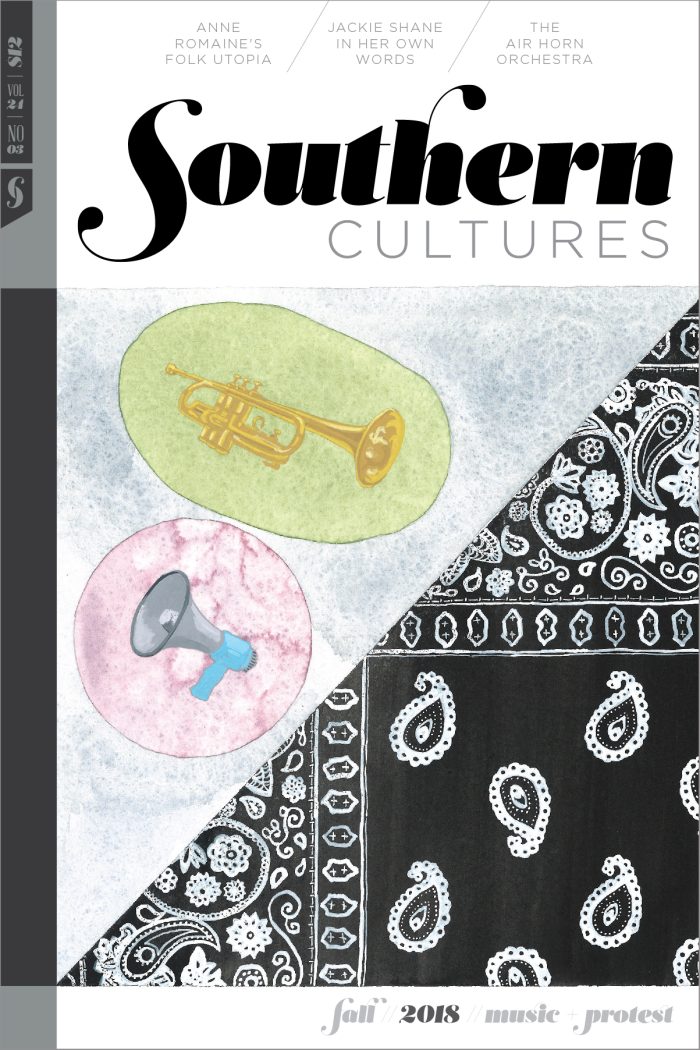“‘Rhythm is who we are—if we didn’t have that, how could we make it?’”
The question is: How do I render sound visible? For me, the answer is ethnopoetics, a mode of presenting performance, ritual, and cultural expression through the tools of poetry. In its possibilities for mirroring moments, and reflecting the spaciousness and impact of tone and silence and sound, the form seeks freedom from the strictures of prose.1
This is an ethnopoetic journey that invites rhythmic reading—listening with the eyes.
Listen.
On an early winter Friday in Raleigh, North Carolina, a gathering was afoot. Stitched through the collected and collective souls was a shared, fierce, and tender passion for stewarding, writing about, archiving, talking about, crying about, dreaming about
Black-ness.
North Carolina Black-ness—Afro-Carolina.
These teachers, filmmakers, curators, land conservationists, and poets were gathered to dream together, to call forth a new vision of how to best preserve the traditions of African Diaspora peoples, of and in this place.
One poet, visionary, and Afrofuturist among us, Darrell Stover, charged the air of the gathering with a selection from his self-published Somewhere Deep Down Within. The piece he chose was “Is the Beat for Max Roach.”
Max Roach—
Bebop pioneering jazz drummer, born in New Land, Pasquotank County, North Carolina.
New Land was not far from the Great Dismal Swamp, which served as a hiding place for generations of freedom- seeking, enslaved Africans. Their “maroon colony” was marked by mystery, extra-legal timbering, and resilience.
In response to Stover’s poetic offering, I declared Max Roach’s rhythms a strategy of resilience, a mechanism by which we, as a people, remember ourselves and fuel our journeys forward.
The percussive resilience of Black people on North Carolina soil led me to consider a sonic heritage, resulting in an incomplete inventory of these rhythmic manifestations, such as:
Church tambourinists.
Rice cultivators with mortar and pestle, and the rhythmic labor of woodsmen and fishermen.
Railroad “gandy dancers,” who lined track in unison, often singing ribald and reverent songs interchangeably.
Culinary architects, mixing dough in wooden bowls, dropping peas in pots, and chopping vegetables.
Foot stompers on wood-floored churches.
Renowned drummers, such as Melvin Parker of Kinston, North Carolina.
Spoon and bone players.
Street protestors with hand claps and drumbeats.
Drumliners from schools and communities.
Step team members from historically Black Greek organizations.
North Carolina Jonkonnu drummers of goat-skinned gumba boxes, who leveraged Christmas revelry, creating a syncretism of Diaspora festival aesthetics, from the Colonial period until the birth of the Jim Crow era, and again as reenactors resurrected the tradition in the late twentieth century.
Line dancers (“Left foot, stomp!”).
Fiddlers and banjoers.
New diasporic souls brought Caribbean, West and Central African, Afro-Latinx, and Afro-Brazilian rhythms expressed in new ways on Carolina land—beats from the same source speaking to each other.
And soul clappers.
What’s a soul clap?
Soul clapping is the shared and improvised rhythm-making by a collective—usually at church, at a party (particularly a basement dance party, or, perhaps, hole-in-the-wall juke joint), or at a sporting event affiliated with a traditionally Black high school, college, or university. The syncopation generally grows in speed and volume as more and more participants join in. The effect is emotionally lifting, empowering, perhaps intimidating. It is unifying and transformative and cathartic.
According to percussionist Mavis Gragg, “It’s a specific type of clap, and I think that it’s an invisible connecting chain in our culture.”
The voices below are a soul clap.
They are expressions of Black-ness and survival.
Listen.
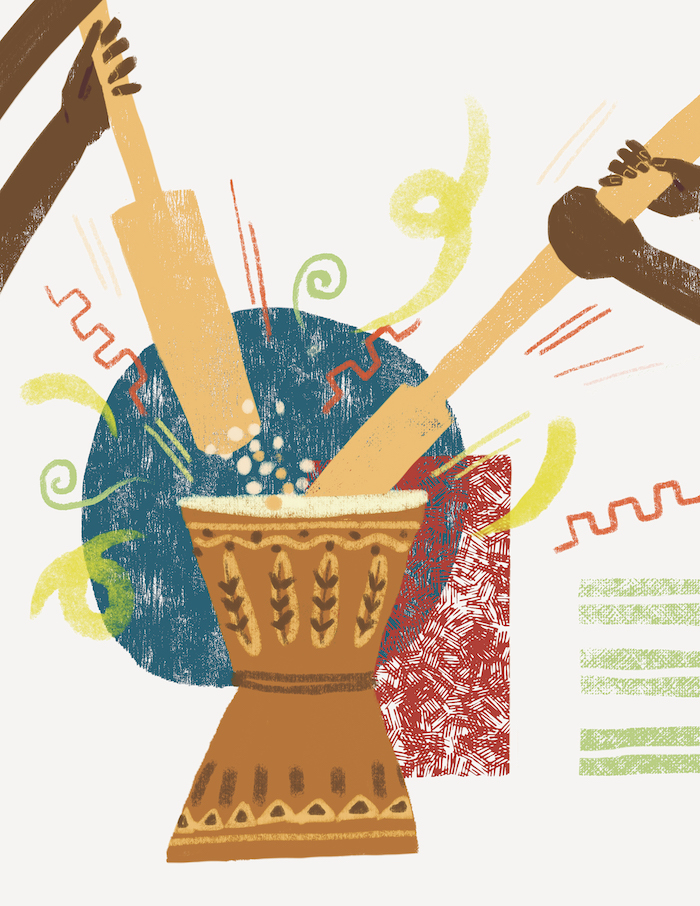
Mollie Hunter, Tambourine Player, Wilson, North Carolina
I never really asked my mother to buy me one.
When I was a child I made me a tambourine.
Now I took a cardboard,
and circled it.
And I took tape.
And I took bottle caps and put holes in it.
And I made me a tambourine.
And so, I spent time just beating it and just beating it!
And trying to make rhythms, just beating it.
I saw that my mother watched me.
She’d say, “Oh, girl! Play that!”
I’d try to tear it up and couldn’t.
. . .
I feel a surge, I would call it an anointing.
I feel the anointing of God moving when I play.
. . .
The jingles on the tambourine put the people in a dance, okay?
It puts a dance in your spirit, it puts the people in a dance.
It has a powerful role in the spiritual realm.
The jingles on the tambourine cause the enemy to flee.
. . .
In our culture, music is a powerful force for our people,
because it almost took us to another place,
took us over those rough times.
Music is healing. So when I play the tambourine, even in the band, we know that
it is bringing a healing to the people.
. . .
Rhythm is who we are—if we didn’t have that, how could we make it?
The beat moves the soul.
Your heartbeat is necessary for your life, and rhythm is necessary for your life.
If the beat is not syncopated, if it’s not in sync, it throws you off.
Our life is like a constant beat and it’s got to be on rhythm, and when you are out
of rhythm, then something’s wrong.
We have to have the beat.
We have to have a rhythm that keeps us
moving forward, living, thriving.
. . .
The things that we do,
stomping of the feet,
causes like a stir in the heavens.
What we need to know about hand clapping is,
Spiritually,
handclapping is a sign of praise
and it is discombobulating to the enemy!
Handclapping changes the atmosphere and it says to the enemy to
“turn it around!”
In the church, handclapping is not just something to do,
It’s a praise,
but also,
it’s a war cry.
It’s turning the enemy’s attack around.
. . .
In heaven, God has the lyre, the timbrel, and the harp.
The timbrel is the tambourine.
Those are instruments that are played in heaven and they have a significant force
here on earth.
I don’t want to start preaching!
Even here,
sometimes,
when I am at home,
I just clap my hands.
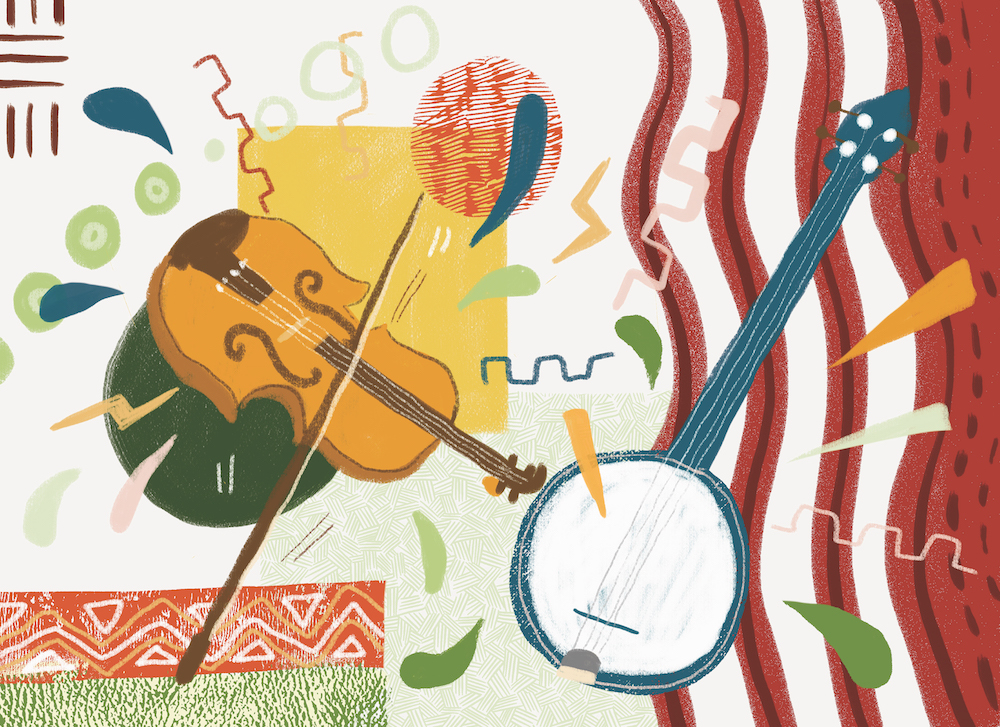
Justin Robinson, Musician, Forester, Cultural Heritage Preservationist, Durham and Gaston Counties, North Carolina
So.
Even as drums are stripped away from African-descendent people,
the rhythms aren’t going anywhere.
Violin playing gets more rhythmic!
Banjos are played harder!
We are doing more with what we have
to work with.
We are funneling all that percussive energy that we have.
That is so much a part of African life,in the past, and currently,
and we funnel it into all these other places,as a way to keep ourselves
ourselves
in a place that is changing us and is changing all around us.
. . .
Joe Thompson’s fiddling was designed to go with the banjo.
And so it was much more percussive than any White player around there would
have been.
African American fiddling is percussive fiddling.
It’s mimicking of the banjo.
The fiddle and banjo get together and the fiddle gets more percussive.
It just has to.
The banjo is a drum.
It’s a drum!
. . .
The sound of wood on wood,
the mortar and pestle,
the crushing of the rice hulls,
the winnowing of the rice in the winnowing basket,
you basically have a giant maraca.
You have the sound of your fingernails scraping the bowl as you make biscuits.
The sound of a spoon swirling around a pot, all of that
percussiveness is imbued
in our everyday lives.
Now it’s imbued in other people’s lives, too,
but we tend to take that
and recognize that specifically as what it is—hearing the
percussion in everything.
And it makes the work go easier and keeps your mind off your
burning muscles.
It’s not so much a space of liberation,
but a space that has nothing to do with oppression.
It jumps above that
and over it.
It goes underneath it.
It’s tapping into a deeper thing that is not stamp-outable,
that is not killable,
that is not able to be beat out of people,
that hearkens back to the very nature of who Black people are.
So, to me, it doesn’t feel like an anti-oppression tool.
It feels like you are touching the deepest part of yourself,
which does not have anything to do with oppression.
You are not in conversation with the oppressors,
or with oppression itself,
you are talking about you.
Despite all the attempts to make you less than,
to make you three-fifths of a person,
you end up being whole.
There are ways that you can always touch that wholeness,
that five-fifths part.
And I think percussion,
at least to Black America, all over the Black Diaspora,
is a way that we always know
that we are who we are.
Whole.
Always.
Every day.
All the time.
. . .
Lord! To me, that is Black people swimming, like
putting a fist back in water.
Because, those drums [drumlines] were sort of European approved,
in an approved setting,
in the way that trumpets were approved and Europeanized enough.
Approved.
But Black people were like,“We got it!”
We’re going to take these traditions
and really make them our own
and touch the part of us
that we know has already been there.
We’re going to scramble it,
remix it,
and do whatever we want.
It is its own tradition now.
Both in the drumlines of colleges and high schools,
and in the drums of churches,
they are both back in their role,
their ancient role,
of inciting people,
exciting people,
of calling in the Spirit,
of calling in the spirit of victory,
or of challenge.
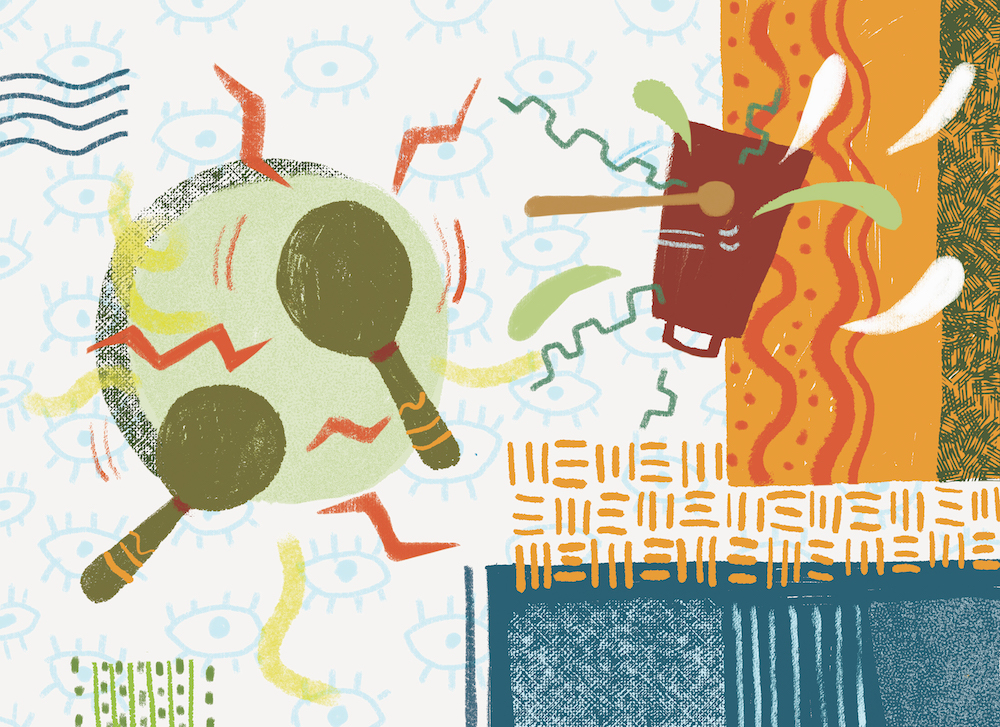
Sharon Bryant, Tryon Palace Jonkonnu Reenactor, New Bern, North Carolina
We use the cowbells.
We use the shakers.
We use tambourine.
We use anything that makes noise.
It’s that beat that really puts you in the spirit.
Kendall McCall, Former Member of the Cold Steel Drumline of North Carolina A&T University
That’s how it is in the HBCU drum world.
It’s all about trying to see
if you can go as hard as you can.
You may talk smack to each other,
but at the end of the day,
you have one goal.
You have to have that—“I’m not scared
of nothing
or nobody”attitude.
But at the same time,you have to be humble.
We just want to bring joy to people.
You’ll always see people smiling,
when listening to an HBCU drumline.
. . .
You got the pastor.
He’s saying something.
One person in the crowd,
you know they really got a praise going on.
And they just need to SHOUT!
You give them that little kick drum,
that DOON DOON DOON DOON DOON.
You see their emotions. You see that reaction.
And then you give them a little bit more.
That’s when you get the rest of everybody else.
They start to see what you’re trying to do.
And you wait for that pastor to give you that look,
Like, “Go on ahead!”And you get the party started.
And that’s the way you’ve got the whole church,
just everybody shouting and . . .
I don’t know.
It’s something about having that control,
and you’ve got to really feed off of what the crowd’s giving you.
If you see that they really need something,
you got to make sure
you’re there to provide it for them.
Mavis Gragg, Lawyer, Land Conservationist, Batalá Durham Drummer, Black Mountain and Durham, North Carolina
I learned about Batalá in 2004, the first time I went to Brazil.
That fall,
I was back in the states, in D.C.,
and saw the D.C. chapter performing at an event.
I was like, “Oh, wow!
That’s so cool!”
The D.C. chapter’s all women,
but they were also
almost all White.
So I was like, if I ever have the chance to join Batalá,
I will.
So that chance came, not when I was in D.C.,
but in Durham,
at the end of 2015.
. . .
Giba Gonçalves, the founder of Batalá,
emigrated from Salvador, in the northeast of Brazil, to Paris.
He decided to start this drumming group,
and it just kind of spread.
The music that they play is samba-reggae.
In Bahia, they were inspired by the civil rights movement in the United States,
to combine this notion of very Afrocentric samba,
and reggae that is also activist music,
but also embracing humanity.
That’s why it was founded,
based on my understanding,
because Black people [in Brazil] were going through
what we went through during the Civil Rights Movement,
and that message got all the way back to Brazil.
And these Afro-Brazilians were like,
“Oh, let’s use our music as a way for social activism.
Let’s honor all the Black leaders in America
and Bob Marley (they LOVE Bob Marley!).
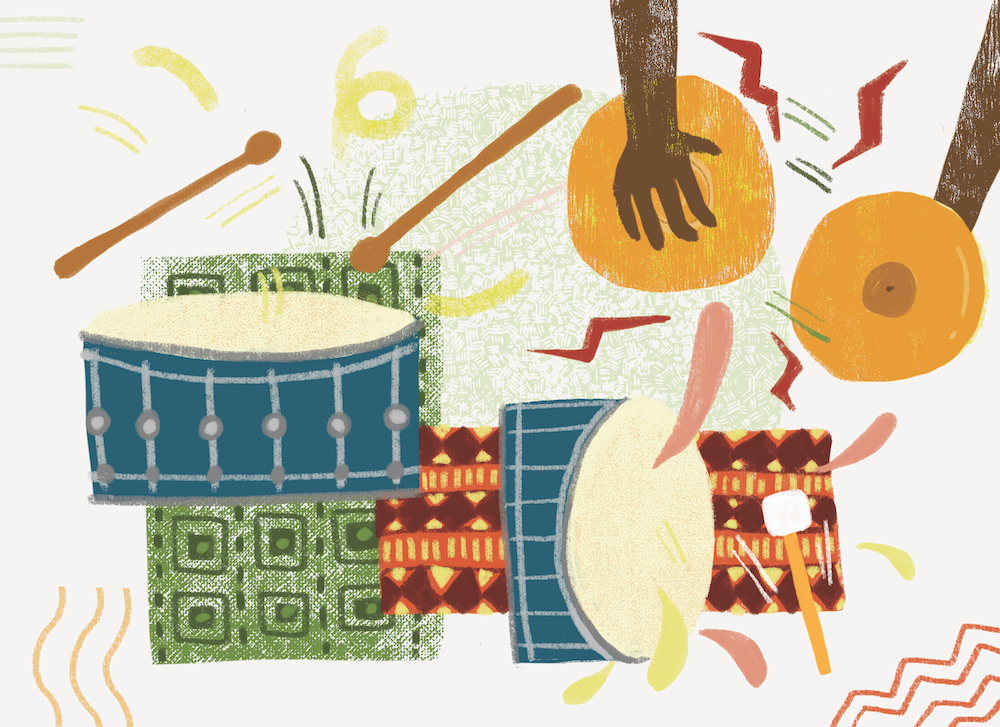
Let’s create music out of this.
And let’s use it in our own protests.”
So.
This went back and forth.
This is before the Internet,
before we had the kind of technology sophistication that we have.
And it sustained over all these decades.
And here it is in Durham.
Our music is being used for a cause . . .
. . .
I thought it was kind of ironic,
that Batalá is Afro-Brazilian music,
founded by an Afro-Brazilian,
but most of the members are White.
So I feel some sort of duty to color.
So it was more so driven by that
than an actual desire to drum,
because I didn’t know how to drum.
I learned when I started Batalá.
. . .
Having this kind of noise,
literally,
I think,
helped push people to think about their place in Durham.
That made me feel good,
because this is what that music is about.
This is the purpose of this music.
There are 20-plus chapters of Batalá.
Durham is one of the newest chapters.
Most of the chapters are in Europe.
We’re the first in the Southeast.
. . .
There’s five other Black women in the group.
And I love drumming with Black women.I love Black women!
I love looking around,
while we’re playing
and we’re really into it.
I love it!
I love that part!
Even my other bandmates.
I’ve grown, I’ve developed friendships
and met people I wouldn’t normally meet and spend time with.
I guess “bliss” is a good description,
for when we’re really into it
and really playing.
That’s what I feel.
. . .
I feel conflicted because on one hand
the music is beautiful.
I love this experience with people,with my bandmates
and with people who come to watch us.
And I feel powerful.
And I love that I am learning something.
I feel satisfied in that sense.
But I also feel that to many people,
we’re a spectacle.
I don’t want us to just be a spectacle.
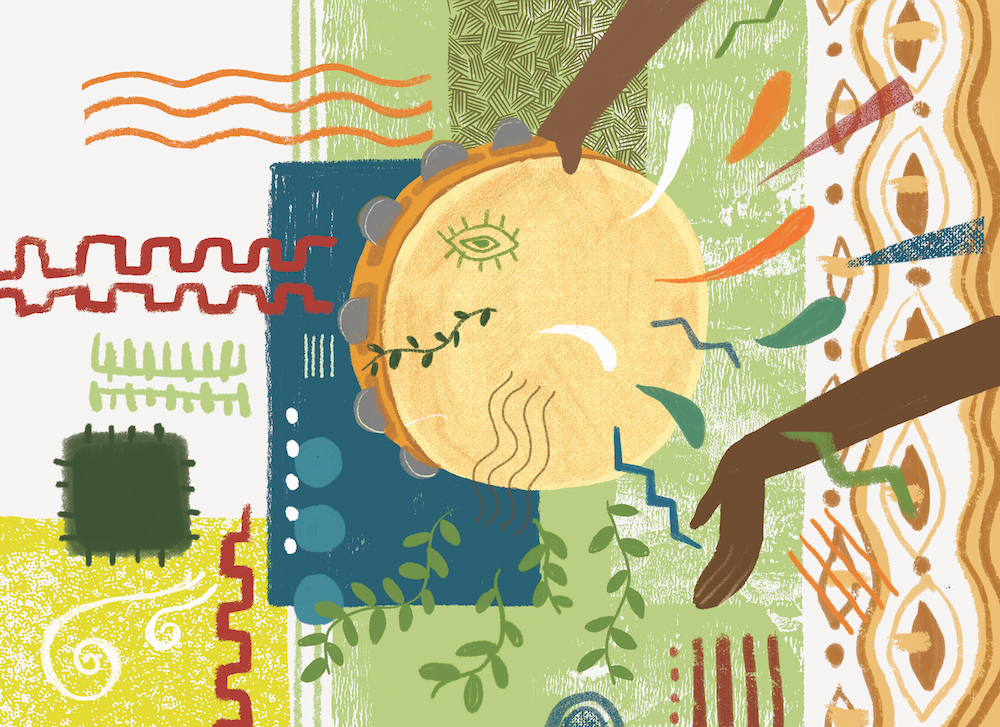
Resonances
The traditions of the percussive, the syncopated, the rhythmic, the steady and countering beats provide a sonic thread on Afro-Carolina landscapes that, while not unique to these spaces within the African Diaspora, manifest in particular ways on Carolina soil and in Carolina souls responding to the land, the toil, the uprisings, the callings, the yearnings.
Drumming, beating, stomping, and syncopating is a catharsis, an expression of power, a marking of moments, place, and time.
Within the arc of Black life in the colonial, antebellum, Reconstruction era, Jim Crow era, Obama era, the era of “45,” percussion has been a continuous cultural thread, a technology for declaring selfhood, ancestral pain and power, communal pain and power, and Afrofuture power. While these traditions can be codified by dominant structures as entertainment or educational—in the case of Jonkonnu, school bands, R&B bands—these syncopations can also be seen as threatening, in the case of street protestors chanting and banging, using spectacle as a force for disrupting oppression.
In the soul claps of laborers and of Spirit, there is an ebullient core rhythm that declares:
I don’t have to push against the obstacle.
The very essence of my soul soars higher than this oppression.
I am whole.
I am free, because I am human,
born of humans,
too strong to subdue.
The clap in my hand,
re-members the ring shout of the lowcountry,
re-members the griot chant,
and re-calibrates the present
and the future,
tapping
and tapping
and tapping.
This essay first appeared in the Music & Protest Issue (vol. 24, no. 3: Fall 2018).
Michelle Lanier is a folklorist, filmmaker, and museum professional. In 2018, she became the first African American director of North Carolina’s state historic sites. She has served as a faculty member at the Center for Documentary Studies at Duke University for two decades. Michelle is the proud mother of Eden.NOTES
- Jerome Rothenberg pioneered ethnopoetics in his groundbreaking text Technicians of the Sacred and advanced the concept in his collaborative work with Dennis Tedlock. As a folklorist and oral historian, I also turn to the foundational work of Dell Hymes and Della Pollock, respectively.

